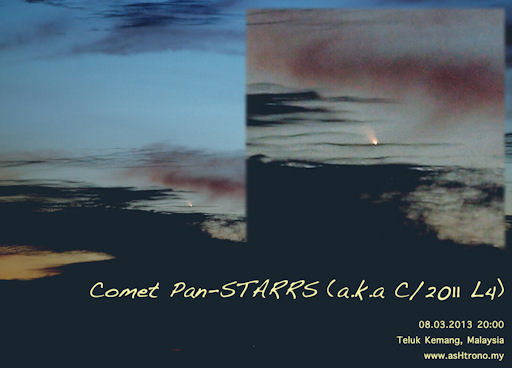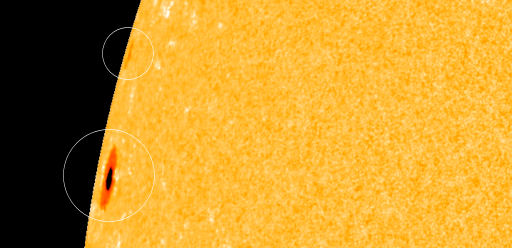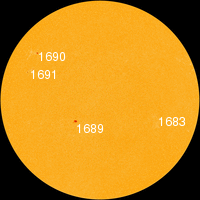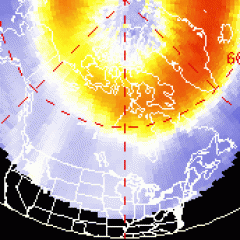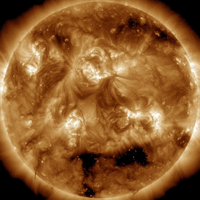SOLAR WIND ENERGY SOURCE DISCOVERED: Using data from an aging NASA spacecraft, researchers have found signs of an energy source in the solar wind that has caught the attention of fusion researchers. NASA will be able to test the theory later this decade when it sends a new probe into the sun for a closer look. Get the full story from Science@NASA
COMET PAN-STARRS MOVES NORTH: On March 10th, Comet Pan-STARRS (C/2011 L4) makes its closest approach to the sun inside the orbit of Mercury. As the comet swings by the sun it is also crossing the celestial equator, moving from southern to northern skies. First sightings of the comet are now coming in from the northern hemisphere. Halda Mohammed sends this picture from Kulim, Kedah, Malaysia (latitude +5o N):
"After several days of comet hunting at dusk, on March 8th I finally caught a glimpse of my first comet ever - Comet PanSTARRS," says Mohammed. "Wonderful! I plan to try again tonight."
If the low clouds part, he'll probably see it again. Worldwide observers report that the comet is glowing about as brightly as a 2nd magnitude star, similar to the stars of the Big Dipper. Technically, that makes it a naked-eye object. The only problem is bright evening twilight, which competes with the glow of the comet. Look low and west after sunset; if you can't see the comet, try scanning the horizon with binoculars.
Dates of special interest include March 12th and 13th when the comet passes not far from the crescent Moon. The tight conjunction on the 12th provides a splendid opportunity for sunset photographers. Sky maps: March 12, March 13,
Visibility will improve next week as the comet moves away from the sun. When it is framed by darker skies, Pan-STARRS should become an easy target for naked eyes and small telescopes alike. Check the realtime comet gallery for the latest images.
More: NASA video, 3D orbit, ephemeris, light curves.
NEW SUNSPOT: Last week, a farside sunspot hurled a massive CME toward Mars. Now that same sunspot is turning toward Earth. NASA's Solar Dynamics Observatory photographed it emerging over the sun's eastern limb on March 9th:
Since targeting Mars with a strong eruption on March 5th, the sunspot appears to have lost some of its potency. We shall see whether the active region still has an explosive magnetic field as it rotates around for better viewing in the days ahead. Solar flare alerts: text, voice.

![]()
Solar wind
speed: 358.9 km/sec
density: 5.2 protons/cm3
explanation | more data
Updated: Today at 2117 UT
![]()
X-ray Solar Flares
6-hr max: B4 2051 UT Mar09
24-hr: B4 2051 UT Mar09
explanation | more data
Updated: Today at: 2100 UT
![]()
![]()
![]()
Daily Sun: 09 Mar 13
![]()
![]()
None of these sunspots is actively flaring. Solar activity is low. Credit: SDO/HMI
![]()
![]()
![]()
Sunspot number: 59
What is the sunspot number?
Updated 09 Mar 2013
Spotless Days
Current Stretch: 0 days
2013 total: 0 days (0%)
2012 total: 0 days (0%)
2011 total: 2 days (<1%)
2010 total: 51 days (14%)
2009 total: 260 days (71%)
Since 2004: 821 days
Typical Solar Min: 486 days
Update 09 Mar 2013
The Radio Sun
10.7 cm flux: 115 sfu
explanation | more data
Updated 09 Mar 2013
![]()
![]()
![]()
Current Auroral Oval:
![]()
Switch to: Europe, USA, New Zealand, Antarctica
Credit: NOAA/POES
![]()
![]()
![]()
Planetary K-index
Now: Kp= 2 quiet
24-hr max: Kp= 2 quiet
explanation | more data
![]()
Interplanetary Mag. Field
Btotal: 5.2 nT
Bz: 4.4 nT north
explanation | more data
Updated: Today at 2116 UT
![]()
![]()
![]()
Coronal Holes: 09 Mar 13
![]()
![]()
There are no large equatorial coronal holes on the Earthside of the sun. Credit: SDO/AIA.

